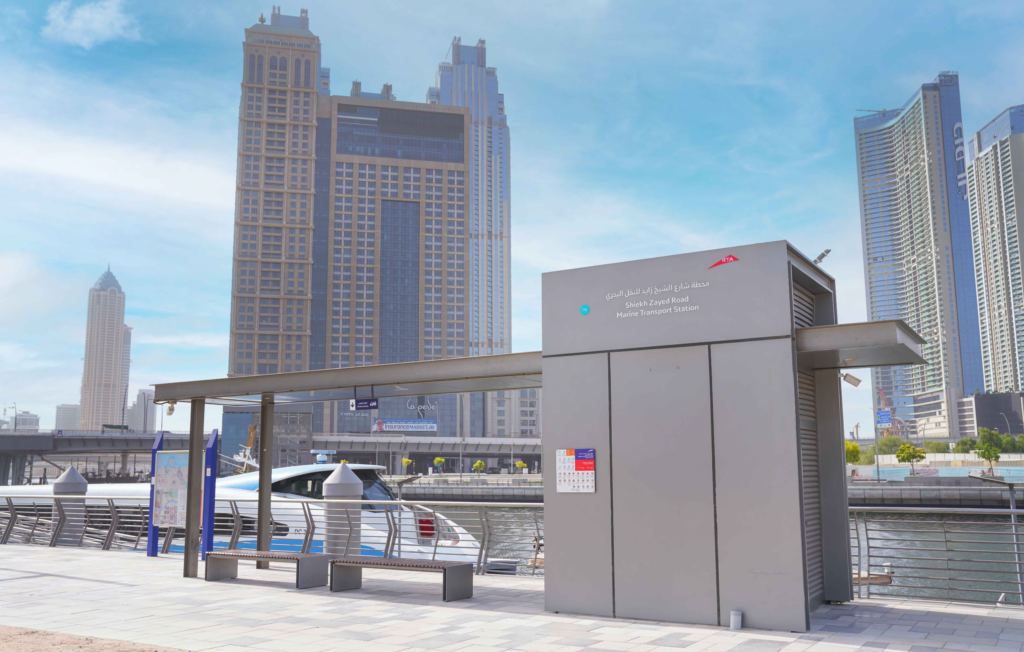Dubai’s Roads and Transport Authority (RTA) has launched the second phase of its marine station improvement project, upgrading key passenger facilities at five important locations: Al Fahidi, Baniyas, Al Seef, Sheikh Zayed Road, and Bluewaters.
The initiative is designed to enhance passenger comfort, improve operational efficiency, and integrate cultural elements into the architecture of Dubai’s public transport.
Focused Enhancements to Meet Growing Demand
With marine transport serving millions each year, these stations are among the busiest in the city. The enhancements target waiting areas and station infrastructure to improve the overall passenger experience, especially in hot weather.
The new station designs will feature:
- Fully air-conditioned waiting lounges
- Seamless wheelchair and stroller access
- Designated zones for People of Determination
- Shaded outdoor seating and energy-efficient lighting
These measures reflect RTA’s broader mission to ensure a smooth, inclusive, and stress-free journey for both residents and visitors.
Merging Modernisation with Dubai’s Maritime Identity

Designers have upgraded each station with elements that honor the city’s historical maritime roots. Inspired by traditional abras and Emirati architectural motifs, the new structures blend aesthetics with practicality.
The goal is to create transit points that don’t just serve a function but also reflect the city’s evolving story—where the past and present coexist in the daily commute.
Serving Strategic Locations Across the City
Each of the five stations chosen in this phase holds strategic importance:
- Al Fahidi and Baniyas: Located in the historic heart of Dubai, often used by daily commuters along the Creek.
- Al Seef: A growing leisure and dining destination where traditional culture meets urban retail.
- Sheikh Zayed Road Station: Positioned along Dubai’s main artery, offering water access amid a skyscraper-dominated landscape.
- Bluewaters: Serves a popular tourist hub, located near Ain Dubai and upscale entertainment spots.
The upgrades are expected to encourage greater use of marine transport, which already supports over 16 million riders annually.
Supporting Accessibility, Safety, and Smart Mobility
Beyond comfort and design, the revamped stations introduce several upgrades in terms of safety and usability. These include fire prevention systems, updated surveillance infrastructure, and better crowd management layouts.
Additionally, the stations are being aligned with Dubai’s vision for smart mobility, ensuring future integration with other modes of transport such as metro, buses, cycling paths, and pedestrian networks.
Building on the Success of Phase One
This second phase follows an earlier round of improvements across Dubai Marina, Ghubaiba, and Dubai Canal stations. According to the RTA, these initial upgrades resulted in increased satisfaction scores and smoother operations, encouraging the next step in a city-wide plan.
Phase 2 continues to raise the standard for public transport infrastructure, placing marine transit on par with Dubai’s highly rated metro and road systems.
The RTA has long-term plans to grow the marine transport network, with upcoming projects focused on expanding routes, adding electric vessels, and incorporating advanced tech like real-time tracking and contactless payment systems.
The current upgrades form the foundation for this growth, as Dubai prepares to accommodate a rising population and increased interest in sustainable, scenic commuting options.
Read More:
- Amazon Prime Day Extends in UAE – Social Kandura
- De Ridder pulls off narrow win over Whittaker in an Abu Dhabi classic – Social Kandura
For the latest updates on public transport developments, infrastructure news, and what’s happening across the UAE, follow Social Kandura for fresh, on-ground coverage that keeps you informed.











